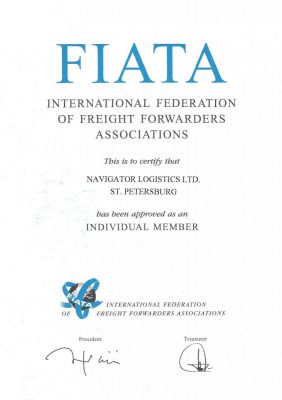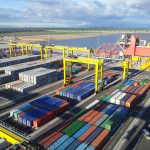 The year was full both of accomplishments and disappointments. The port complex of the country as usual demonstrated freight throughput growth, and once again largely Russian raw product exports contributed to cargo volumes gain. Inland shipping again teetered on the brink of collapse, now closer to a halt of transit cargo shipping.
The year was full both of accomplishments and disappointments. The port complex of the country as usual demonstrated freight throughput growth, and once again largely Russian raw product exports contributed to cargo volumes gain. Inland shipping again teetered on the brink of collapse, now closer to a halt of transit cargo shipping.
Raw growth
By the 2015 year-end results cargo volumes handled at Russian seaports rose 3% y-o-y to about 650 million tonnes (provisional figures). More than half of this volume accounted for exports crude oil and oil products from Russia. This year, the increase in liquid bulk segment was 5% compared to last year. The third in terms of volumes handled at the country’s sea ports was coal, yet another Russian export raw commodity.
Despite oil prices dive, the upward trend will most likely continue in oil liquid bulk segment. In 2015, several new port projects were announced for the export of hydrocarbons. The total volume of oil product exports through Novorossiysk based Sheskharis Terminal is expected to jump by more than twofold in 2018 and amount to 20 million tonnes per year. Marine Terminal of Neftegazindustriya Group controlled by Vladimir Kogan of annual capacity of 11 million tonnes could be built on the Black Sea in the Bay of Tsemess, near PenaiCape. The terminal is projected to handle products produced at modernized Afipsky refineries. The terminal for handling Russian crude exports “Transneft – Port Kozmino” based in Vostochny, Primorskiy Kray plans to boost its capacity by 20% in 2017 to 36 million tonnes annually.
FSO Belokamenka after 12 years of operation offshore Murmansk port in November 2015 left the Russian port anchorage and returned to Kirkenes to her Norwegian shipowner. In January 2016 a new FSO of RPK Nord with annual capacity of 12 million tonnes will replace Belokamenka and start operation in Murmansk. FSO Umba will be transshipping export oil of Gazprom Neft delivered from Novoportovskoye field.
Stevedoring infrastructure specializing in handling export coal continued expansion in 2015. The Far Eastern region saw the most ambitious construction of coal terminals. For example, Vostochny port, the largest coal terminal in the country is implementing an investment program for construction of ammonia terminal Phase 3. There’s a slew of new projects for construction of coal terminals, namely in the ports of Vostochny, Nakhodka, Vanino, Posiet, etc. but their fate is quite unclear.
Containers volume: less than projected
Unfortunately, high-yielding containerized cargo flow is still bypassing Russian ports. During the previous 2014 year container throughput at Russian ports fell 1%, and at the end of this year container volume plummeted by 25%. Year-to-date Russian container terminals handled only 4 million TEUs. Sadly, but this volume just slightly exceeds quarter box traffic at the port of Rotterdam!
Apart from the general downturn in the Russian foreign trade, there is still a number of factors that affect negatively operation of domestic container terminals. Among the main reasons for this situation is imperfection of the customs administration in Russia, short storage free times at the domestic terminals and high tariffs for storage services.
The Russian government has been taking measures to improve customs administration, developed a special “road map” to change the situation in seaports. However, the “a single window” scheme in the sea ports has not yet implemented, a single list of documents with cargo information to be submitted to the customs authorities has not been approved so far, and there is no integration of data exchange systems of various government supervisory bodies.
The project of outer harbor Bronka successfully completed on-time and on-budget in St. Petersburg appeared to be a major event for the Russian container market. The investor / developer of the new terminal Fenix LLC in September 2015 took delivery of the first commercial consignment, and in late December, announced it had signed agreements with the world’s largest container liner operators to handle calls. Hopefully, Port Bronka will facilitate the inflow of the containers to Russia from the neighboring rival ports.
More newbuildings
In 2015 shipbuilders delivered to FSUE Rosmorport two 16MW diesel-electric icebreakers “Vladivostok” and “Novorossiysk”. Nevsky Shipyard has completed construction of fourth multipurpose salvage ship 4 MW Spasatel Demidov. Wismar, Germany based Nordic Yards built for FBU Morspassluzhba Rosmorrechflot two versatile ice-class 7MW salvage ships.
However, there was a big fly in the ointment. A shipyard of United Shipbuilding Corporation failed to execute on time a contract for a powerful diesel-electric icebreakers LK-25 for Rosmorport. This icebreaker keel was laid at Baltiysky Shipyard and is scheduled for completion in 2017. However, some doubts still persist about the success of this project.
At the end of December 2015 USC President Alexey Rakhmanov explained in an interview with IAA PortNews that at the LK-25 design development stage engineers made serious miscalculation. “Actually, we had to LK-25 to build in a new architecture. To date, the issue (additional funds for the project completion – IAA PortNews) is being considered by the government. We hope that soon a decision will be taken”, USC’ Rakhmanov was quoted as saying. At the same time, he said, the superstructure for the icebreaker will be completed at St. Petersburg based Baltiysky Shipyard (St. Petersburg). Previously, for the superstructure order was place with Nordic Yards, but now managers at USC believe the contract with a European company is unprofitable because of the ruble devaluation.
In addition to state orders, this year Russian shipyards completed and newbuilds for private customers and executed a number of contracts for ice-class commercial fleet.
Vyborg Shipyard based in Leningrad Region on November 3, 2015 laid keel of a flagship in a series of two icebreaking support vessels for Gazpromneft. The lead ship was named “Alexander Sannikov.” Two icebreaking vessels will operate at the Arctic terminal of the Novoportovskoye field on the western bank of the Ob Bay (Yamal peninsula). The newbuilds are scheduled for delivery in by 2018.
BP Tanker signed the largest in 2015 civil shipbuilding contracts for seven mixed sea/river class oil tankers with Krasnoye Sormovo (part of USC) and Okskaya Shipyard (member of UCLH). Lessor in the contract was PJSC State Transport Leasing Company (GTLK). The contracts include 3 RST-54 series combination bulk oil / deck cargo carriers and 4 tankers of RST-27 series. Okskaya Shipyard was contracted to build for BP Tanker 5 vessels: 2 RST-27 and 3 RST-54; Krasnoye Sormovo – 2 RST-27-design ships. All these combo carriers were designed by Marine Engineering Bureau. The newbuilding contracts is valued at approximately $ 100 million.
Shallow depths
Shallowing of the rivers constituting the Unified Deep Water System of European Russia hit the shipping community and cargo owners in summer 2015. River traffic came to a halt on the Volga in the area of Nizhny Novgorod with some changes in river cruise itineraries schedule and export oil products shipping. The volume of products delivered to Big Port St. Petersburg from refineries scattered along the river dropped by more than twofold. In the 2015 navigation season it was the first time over the past few years that FSOs were not anchored offshore the port of St. Petersburg for receiving and storage oil products from river vessels. Almost all export loads were moved to the south through the port of Rostov-on-Don. However, the southbound route was also complicated due to low water on the Don and only 8 million tonnes were shipped via the river, a third less of volume transported in 2014.
At the end of the navigation cargo ships passed the Don underloaded by 40%. The river shipping business may not survive yet another similar situation.
Especially, taking into account that exercise duty on ship low-viscosity fuel (CMT) becomes effective as of January 1, 2016, the product grade widely used on the river, which will increase the cost of bunkering.
The reasons for this situation and ways to find a solution will be discussed at the State Council meeting chaired by President Vladimir Putin in 2016.
Rosmorrechflot, due to the federal budget deficit, proposes to redirect the funds assigned for the construction of the second line of Nizhnesvirsky hydroengineering complex (Leningrad region), to finance the projects of Bagaevsky system (Rostov region) and Gorodetsky (Nizhny Novgorod region). In any case, without addressing Gorodetsky hydro engineering complex issue, river traffic volume will not increase on the Svir. It was offered to get Nizhnesvirsky project from the shelf after 2020, when they eliminated the bottlenecks in Nizhny Novgorod and the Don.
Major change at the helm of Railways
The change of the Russian Railways president can be named the Appointment of the Year.
Oleg Belozerov, appointed as the head of Russian Railways in August 2015, is no stranger to the infrastructure problems of the transport sector, which allows us to expect him to give a “green light” to projects of direct rail access to ports.
In the meantime, the debate on rail freight tariffs adjustment for transportation in 2016 for the first time changed its vector in favour of the cargo owner. The rate is expected to be increased by 7.5% in the tariff limit set by the Federal Antimonopoly Service (FAS, taking into account the merger with the Federal Tariff Service, FTS) at 9%. Previously, the railroad sector demanded tariff adjustment in the amount significantly exceeding the limit set by the FTS. This measure will not only help strengthen the economy but also increase the throughput at the seaports of the country.
Porto Franco Vladivostok
Federal Law of the Russian Federation dated July 13, 2015 (№ 212-FZ) “On the Free Port of Vladivostok”, came into force on October 12, 2015 was primarily intended for the development of territories, rather than on the development of marine terminals. Porto Franco mode is effective on the territory of 15 municipalities of Primorsky Krai. The total area of the Free Zone comprises 28,400 km2, populated by 1.4 million people.
In continuation of this agenda Russian president tasked the Ministry of Transport to develops a unificated bill “On the free ports of the Russian Federation”, accumulating all the comments and suggestions from stakeholders. According to the ministry, there have been some 90% of Russian seaports seeking the status of the free port. In particular, the port of Kaliningrad, Murmansk and Arkhangelsk have submitted their requests.
Alas!
Yet another year appeared to be fruitless for the industry in terms of adoption of amendments to the law on ports, although the Ministry of Transport was near to submitting the bill to the government. Amendments to the law “On Ports” (the Law, Nov. 8, 2007 N 261-FZ “On sea ports in the Russian Federation and on Amendments to Certain Legislative Acts of the Russian Federation”) is provided for in the part of the state regulation of activity, of security provision services, of regulation of land and property relations in seaports.
http://en.portnews.ru/comments/2070/
Similar Posts:
-
Throughput of Russian seaports review in the 2017 year
2017 year-end in Russian seaports handled 786.97 mln t of cargo (+9%, year-on-year), says the press center of Association of Commercial Sea Ports. Transshipment of dry bulk cargo totaled 372.94 mln -
Throughput of Russian seaports review in Half-year 2017
In January – June 2017, Russian seaports handled 384 mln t of cargo (+11.3%, year-on-year), says the press center of Association of Commercial Sea Ports. Transshipment of dry bulk cargo totaled -
Russian Railways In 2014: a Half-Year Results
The President of Russian Railways Vladimir Yakunin Sums Up Company’s Performance During 1H 2014 During a conference call on 4 July 2014, Vladimir Yakunin, President of Russian Railways, summed up the



